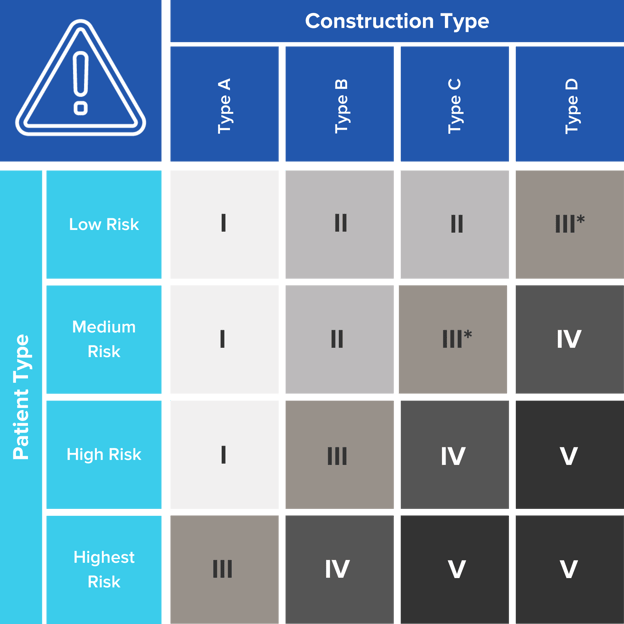Share this
ICRA in a Healthcare Facility: Prioritize Safety of High-risk Patients
by HEPACART on Aug 22, 2023

Nothing is more critical in healthcare facilities than ensuring the safety of patients at higher risk of infection. These individuals are already dealing with medical issues or pain on some level, and it is the responsibility of the healthcare facility to help ease their bodies as much as possible. High-risk patients might be those with multiple chronic illnesses or respiratory issues or are otherwise immunocompromised, and they are particularly vulnerable to the quality of the indoor environment in a medical facility. This is particularly true during construction or renovation projects, which can introduce potential health hazards if not properly managed.
Whenever there are high-risk patients in the mix, the Infection Control Risk Assessment (ICRA) can be a vital resource for your facility to mitigate the risks. ICRA is a key tool in maintaining high standards of health and cleanliness, helping you safeguard your facility and patients — especially those who are most vulnerable in a time of construction or renovation projects where harmful dust and debris can become airborne.
In this blog, we will discuss the importance of infection control for these susceptible groups and show how valuable ICRA can be in keeping them safe and healthy. Keep reading to explore these guidelines' value to your institution.
ICRA: A Complete Approach to Infection Control
One of the initial steps in project planning should be the implementation of ICRA, typically led by an infection control officer. This individual is responsible for a team of people that will conduct the infection control risk assessment. They are tasked with setting up practical precautions that will keep the facility safe and healthy through any kind of construction project, and the ICRA guidelines help to break down every potential area of risk and how to limit them.
This risk assessment takes place in the earliest stages of planning. If the hospital does not initiate contact with the construction team, it becomes imperative for the contractor to step forward and provide their input during the pre-risk assessment phase. The goal is to create a solid plan that everyone involved — facility managers, medical staff, administrative teams, etc. — can rally behind to maintain the highest level of safety for all patients, especially the high-risk individuals who are the most significantly affected.
Balancing Construction Schedules with Patient Care
During the construction phase, it’s important to remember that hospital schedules are the ultimate driving force. Surgeries, procedures, scans, and patient care should come before any disruptions or maintenance projects. Because of this, adjustments may be needed to ensure minimal intrusion within the facility. For example, when surgeries are scheduled, contractors may need to avoid tasks that create vibrations. Similarly, tasks that might kick up significant debris might need to be scheduled when affected areas of the facility are less populated. This kind of attention to detail and coordination goes a long way in maintaining safety and smooth operation within the facility. Thanks to ICRA guidelines, as the facility manager, you don’t have to think independently of each instance where there might be an increased risk.
Extra Caution for High-risk Patients
High-risk patients can be found in any hospital area, but there are certain zones where you’ll want to take extra precautions. The ICRA matrix can help identify these areas, allowing you to map out the risk level associated with your construction project. This way, you can create a tailored ICRA plan that minimizes any potential impact on high-risk patients.

Using the ICRA Matrix
The ICRA matrix is a practical tool that breaks down patient risk groups, project types, and precaution classes. Once you identify each element, the ICRA matrix helps to simplify the process of matching your specific situation with the appropriate precautions to protect high-risk patients and everyone else in the facility.
To figure out the best way to implement ICRA practices in your healthcare facility, you must first determine the specific category that your project falls under. To do this, you’ll need to identify the…
1. Patient Risk Group
The patient risk group is based on the populations within your facility that the construction, renovation, or maintenance project will impact. You’ll need to consider the physical location of the work being done and who may be coming in and out of the general area.
Four categories of patient risk group designations range from low, medium, high, and highest risk to the healthcare facility’s patients.
2. Project Type
The project type depends on the kind of work that will be completed. Whether this means a routine maintenance project or a complete renovation of a space, your project type will help to identify the disruption level that might take place and allow you to plan accordingly.
Project type can be categorized into four levels — type a, b, c, or d — depending on the level of disruption and potential danger to the facility.
By using these two elements, you can identify your precaution class. The precaution classes are I, II, III, IV, and V, each with a checklist of infection control activities. With the ICRA matrix, you can clearly understand your facility's risk level and how to create an effective strategy that suits your specific needs.
Embrace Proactive Infection Control Strategy Planning
Implementing an effective ICRA plan is more than just a regulatory requirement — it’s a key part of upholding patient safety and health standards. With the ICRA assessment, you can protect your healthcare facility from the potential pitfalls of construction projects and advocate for high-risk patients most effectively.
Now that we’ve covered the importance of ICRA, how to prepare for it, and its role in safeguarding high-risk patients in your healthcare facility, you might be ready to implement these practices in your own facility. For a more in-depth understanding and to jumpstart your ICRA planning process, don't hesitate to download our comprehensive ICRA guide today.

